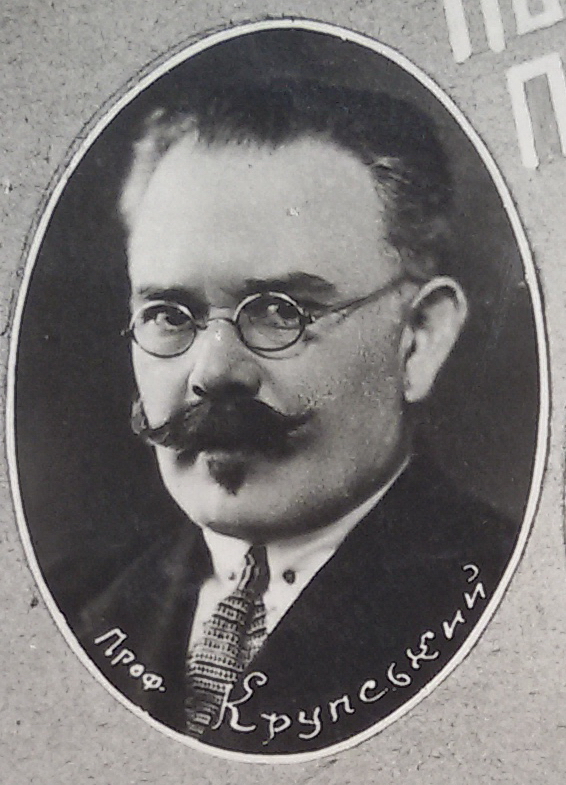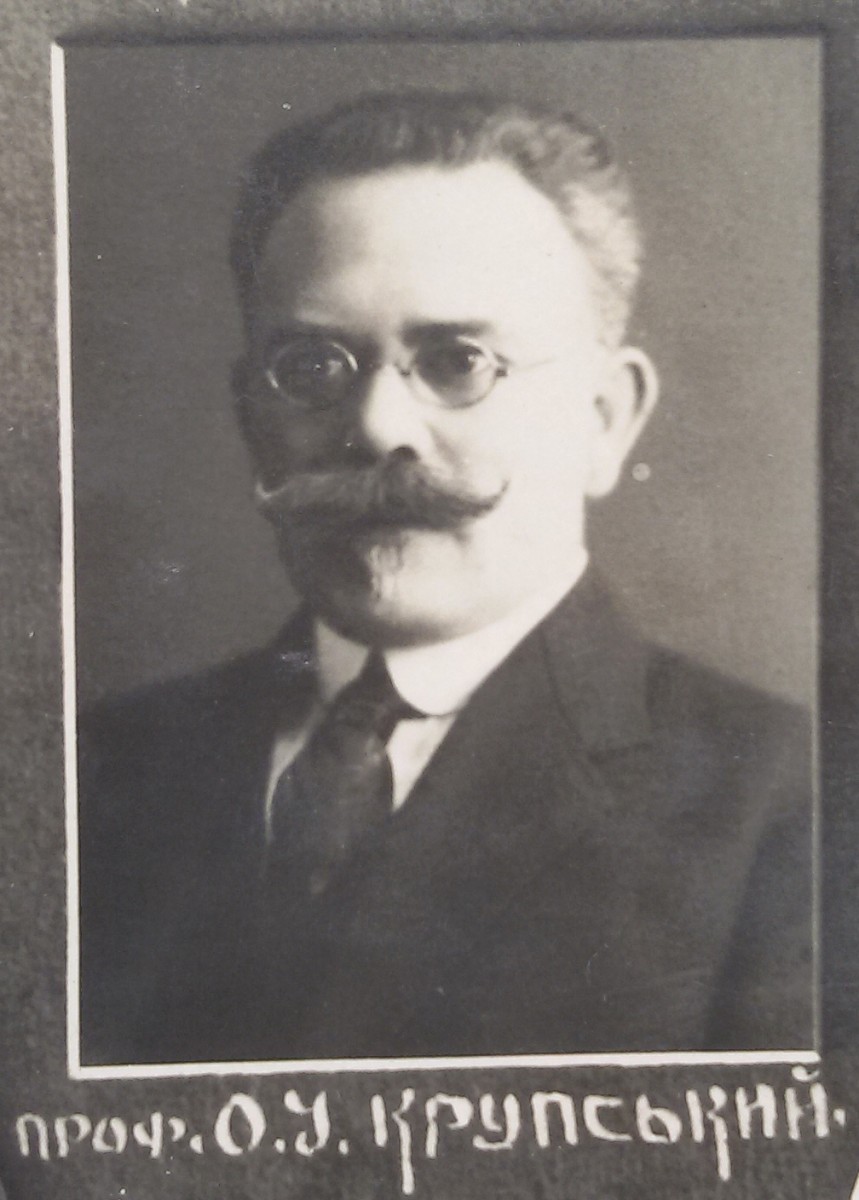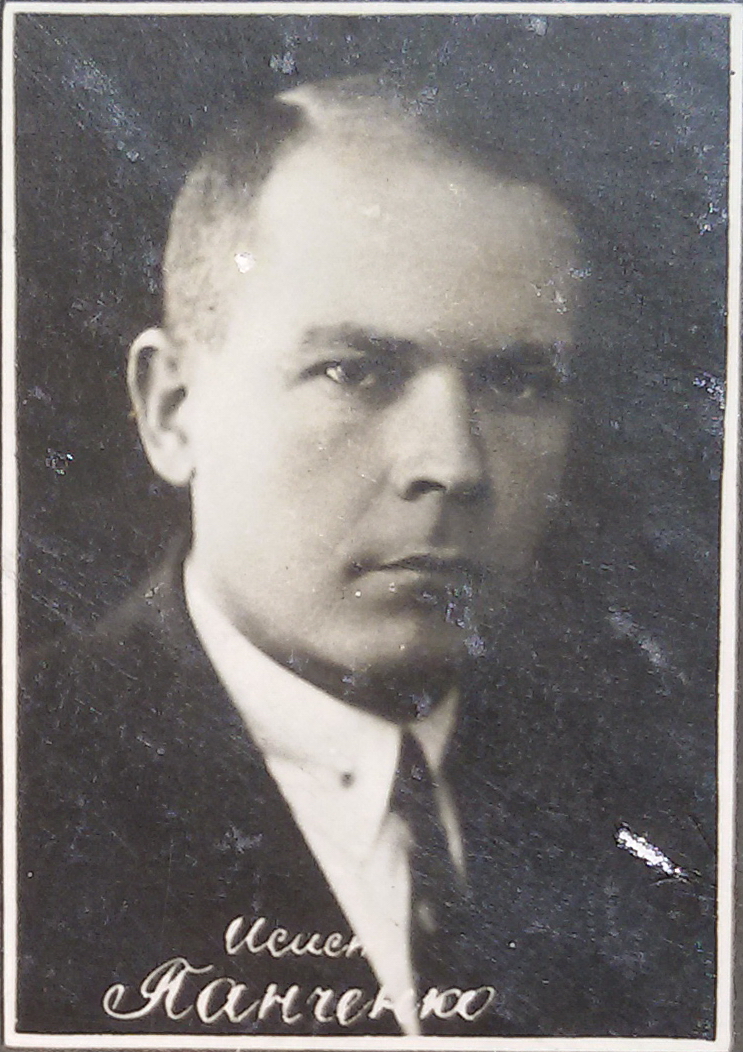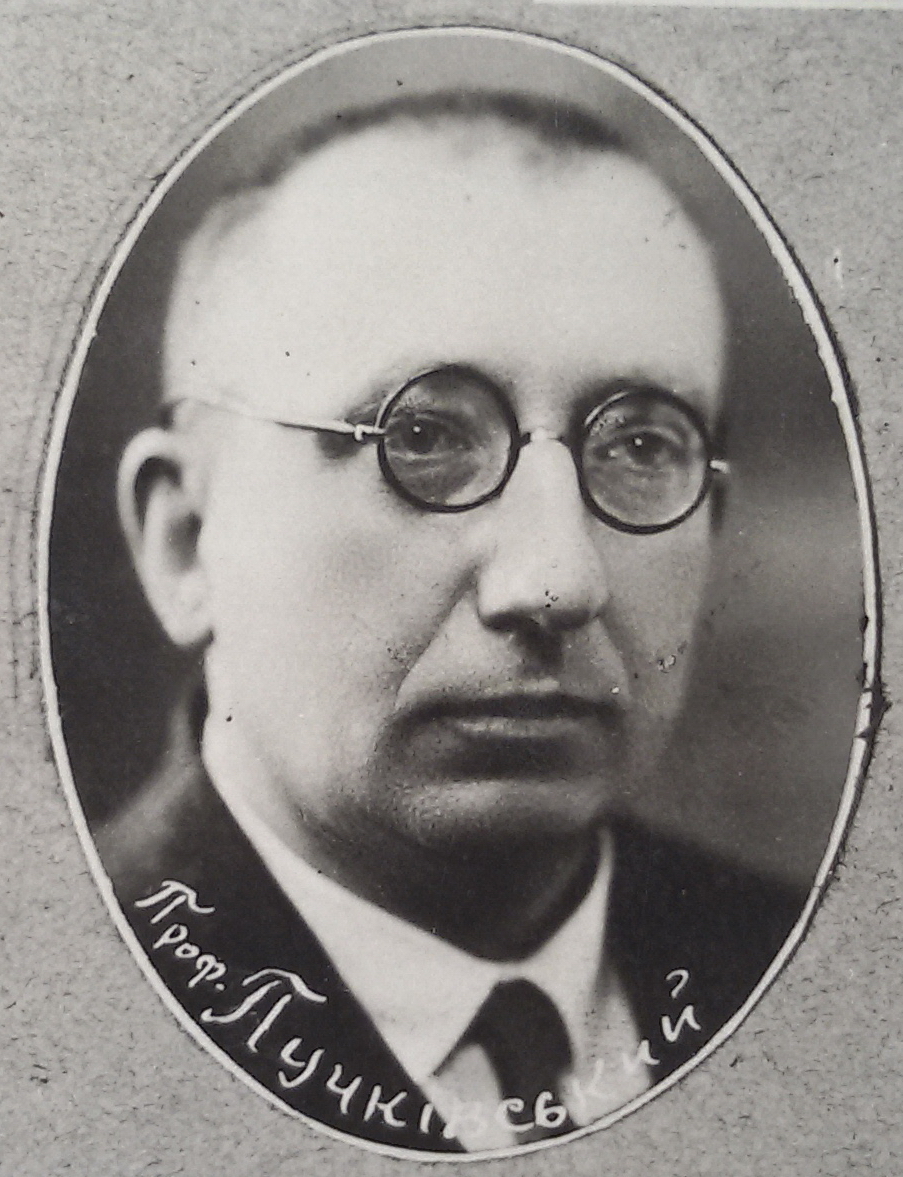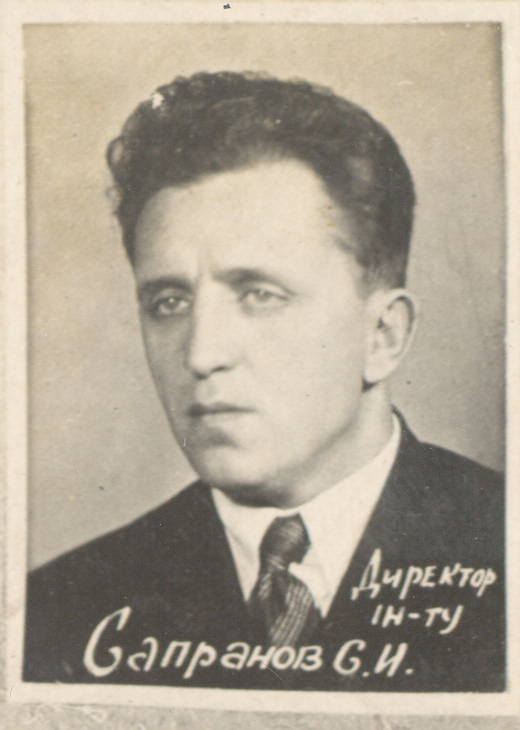KATERYNA AMOSOVA: “GREAT TERROR” IN 1936-38 AMONG ACADEMIC COMMUNITY OF KYIV MEDICAL UNIVERSITY. PART II
“The total lie shall compulsory bring the result – it is important that it would continuously be implemented and cover the maximum amount of people”
Y. Gebbels
We have the most information about professors O. Puchkivskyy and O. Krupskyy among professors and teachers of KMI, who were repressed in 1937-38.
Oleksandr Mytrofanovych Puchkivskyy (1881-1942) – founder of department of otorhinolaryngology at KMI. He started his way in medicine as a military doctor, who traveled many cities of Russian empire for many times.
After graduate military course at Saint Petersburg military medical academy in 1913 he defended the dissertation for acquisition of scientific degree of Doctor of Medicine: “Historical essay about food provision of Russian army”. Since beginning of the First World War he served as the head of sanitary train together with his wife – sister of charity, later – at sanitary administration of Romanian front. He worked as the chief doctor in Odessa military clinical hospital No 412 before electing to the post of head at department at Kyiv medical institute in 1921.
He was at the head of department of otorhinolaryngology, which he founded at KMI, until his arrest in November, 1937. During this period he became the well-known scientist in the USSR and doctor. He published the first Ukrainian textbook “Diseases of ear, nose, throat and larynx”. The sentence, announced to the family, was “10 years without the right of correspondence”. Such formulation usually meant the execution. There is no exact information about date of death of O. Puchkivskyy. The memorial plate of the building of clinical hospital No 18 in T. Shevchenko Boulevard, 17 mentions 1942. There is information that he died in prison from oncologic diseases. In 1957 the scientist was rehabilitated.
The older daughter of O. Puchkivskyy Nadiia (1908-2001), who at the moment of her father’s arrest worked as an assistant at department of histology at KMI and was finishing the candidate’s dissertation in morphology of eye cornea epithelium (1938), was immediately dismissed from work. And after speech by Y. Stalin with the thesis “children are not responsible for their parents”, she was renewed at work and defended the dissertation. During the war N. Puchkivska worked as the head of eye department in evacuation hospital, and since 1946 until the end of labor way – at Odessa institute of eye diseases and tissue therapy, firstly under supervision of V. Filatov, and in 1956-85 – as a director. She is known as a famous authority in transplantation of cornea and treatment of eye burns, academician in AMS of USSR (1971).
Younger daughter of O. Puchkivskyy, Galyna (1934-2010) – Doctor of Physics and Mathematics, professor, head of department at institute of physics at NASU.
Oleksandr Ivanovych Krupskyy, professor, obstetrician-gynecologist, was born in 1875 in the family of the priest, graduated from medical faculty in Derpt (Yuryiv) university in 1919. One of participants in congress of Ukrainian doctors (still when a student), member in Ukrainian central council of UPR (1918) as a deputy from Baltic fleet in Kronshtadt society “Prosvita”.
In 1919 he became the senior assistant, later – privat-docent at department of obstetrics and gynecology at KMI of Ukrainian lectureship. In 1920 he defended the Doctor’s dissertation “About Cleland’s pliers”. In 1924 he became the secretary of Kyiv obstetrician gynecological society and started publishing the scientific works in Ukrainian.
In 1929 he was elected to the post of member in methodic section of AUAS, professor at department of Odessa medical institute.
In 1930 he returned to Kyiv due to his election to the post of head at department of obstetrics and gynecology No 1 at KMI, where he was at the head until arrest in 1937. During that time he was fruitfully engaged into scientific problem on labor pain relief and was the pioneer of its mass implementation in Ukraine at the state level. The first Ukrainian textbook in operative obstetrics (1931-1936), Ukrainian and Russian monographs “Labor pain relief” (1936), “Juvenile hemorrhages” (1935), etc. were issued with his participation.
- Krupskyy is famous as a talented surgeon, who trained many famous pupils, in particular, professors P.M. Buteyko, L. Melnyk, M. Ventskivskyy. The latter one became his successor at the post of head at department in KMI.
O.I. Krupskyy was arrested in 1930 in connection with the “Case of ULU” but he escaped from imprisonment. He got into repressions in 1937 after publication of the article in newspaper “Proletarian Pravda” under title “Double “accounting” by professor O. Krupskyy. Harmful activity of double-dealer and his enemy “center” in the obstetrician gynecological clinic No 1 at Kyiv medical institute”. He was dismissed from work and arrested (Ya. Ganitkevych, P. Pundiy, 2008).
Although in some months O. Krupskyy received the freedom, he was forbidden to live and to work in Ukraine. The scientist with great difficulties managed to find a job in Voronezh at the regional institute of motherhood and childhood. Later after long agreements he became the professor in Voronezh medical institute and director in clinic of obstetrics and gynecology (1939-1943).
Possibly, he died in 1943 in Moscow and was forgotten in Motherland for a long time. The first information about life and activity of O. Krupskyy appeared in the jubilee Who was Who by heads of departments at O.O. Bohomolets NMU in 2001.
The pro-rector on academic work at KMI O. Panchenko and his wife, assistant at department of obstetrics and gynecology V. Panchenko-Liubchenko, sister of member in CC CPU O. Liubchenko, who did not wait for arrest and shot himself in 1937, were arrested in August, 1937.
The available information about Oleksandr Danylovych Panchenko is limited by a short text in “Who was Who” of KMI, issued in 2001. He was born in 1899, graduated from KMI in 1929. Since 1929 until arrest in 1937 he worked as an assistant professor, head in course of urology at department of hospital therapy. Author of 20 scientific works. He died in prison, possibly in 1942.
As O. Bobrov mentions, (“Archipelago “Medlag”) the assistant professors at KMI I. Anistratenko (hospital surgery) and E.E. Kryster (EENT) were dismissed from work in 1937 for contact with “people’s enemies”.
According to the testimonies by Yu. Vilenskyy, in the archive of NMU there is the terrible document: answer for request by investigator in Prosecutor’s Office of UkrSSR, dd. 10.03.1938, where it is mentioned that the assistant at department of chemistry N. Dubynskyy, assistant at department of therapy S. Sapronov, assistant professor at department of propedeutic therapy V. Michelson, were dismissed from work as people’s enemies in 1937-1938, as well as hourly teacher at department of biology Vira Romanenko and Resident Medical Practitioner at department of nervous diseases Mariia Gromova (dismissed from work as relatives of “people’s enemies”). Further, due to submission of NKVD, the professor at department of hospital therapy M. Svenson and assistant at department of children’s surgery Mykola Liubchenko (as a relative of enemies) were dismissed. The assistant at department of epidemiology S. Rybynskyy was dismissed and arrested. The then assistant at department of microbiology S. Diachenko, future professor and head at this department was arrested.
Ya. Ganitkevych and P. Pundiy also add the assistant professor Ivan Sereda (1933), teachers Serhii Drapaliuk (1935) and Ksenofontiy Palamarchuk (1938), students Roman Klymenko (1938), Mariia Plakhotniuk (1933), Ivan Nikolayenko (1933), Maksym Golub (1935), Ivan Bilda (1938), Oleksandr Kuzmovych (1941) to the list of repressed employees and students of KMI during this period.
I am sure that this list of repressed people during the years of “great terror” is far from complete…
As Ya. Ganitkevych mentioned (2010), before beginning of the Second World War at KMI there were no former professors from medical faculty at Ukrainian state university. Most of them were dismissed as a result from repressions, some of them died in prison. Only M. Neschadymenko 1869-1942 (microbiology), M. Levytskyy 1871-1942 (head at department of eye diseases) and O. Tyzhnenko 1874-1944 (dermatovenereology) and pupil of professor G. Ivanytskyy – professor I. Studzynskyy (operative surgery and topographic anatomy) remained among professors of Ukrainian lectureship at the beginning of work in reorganized KMI.
The history keeps not only the broken destinies of innocent people but the testimonies for efficiency in terrorizing as a result from terror, caused at state level.
Yu. Kundiiev in his book mentions the following fact. In October, 1936 they adopted the special Decree by CC CPU “About Ukrainian institute of experimental medicine and its director Ya.I. Lifshits” with accusation in infringement of “general line” of the party in relation to organization of health care. The statement of director about “disappearance” of therapeutic medicine as if witnessed about his “Menchevik idealism”, and the expression about similarity of Soviet sanitary inspection with English one – that he is “the apologist of bourgeoisie”.
The leading scientific worker at institute professor Liberman was accused in anti-Soviet position as he related the infectious disease rate with the sanitary conditions in the country but not the conditions of public development.
The party criticism was at once loudly supported by his colleague-head at department of social medicine and organization of health care at KMI professor S. Kagan. The journal “Preventive medicine” in 1937 (No 2) published his accusing article under expressive title “To clear the health care from bourgeois littering”.
There are no data about further destiny of professors Lifshits and Liberman but there are no doubts that it was tragic. The institute of experimental medicine was quickly broken up.
Professor S. Kagan (1894-1965) worked as the head at department of KMI for long 23 years (until 1952), was awarded with the Order of the Red Flag. In 1933-34 he suffered from severe criticism for some “false” positions of his textbook for students, in particular, underestimation of significance by revolutionary transformations for improvement of public health and absence of description of “wrong” features for bourgeois social medicine, to which the classics of Marxism and Leninism pointed out. S. Kagan “confessed”, publicly acknowledge his mistakes and gave the “correct” assessment to them, in particular, in his article “For Bolshevik self-criticism” (1934). (S.G. Usenko // Medicine today and tomorrow – 2013 No 4).
In 1964 the journal “Soviet health care” published the jubilee article by L. Lekarev “Professor S.S. Kagan (to the 70th anniversary)”.
Academician I. Pavlov laureate of Nobel Prize in his letter to the people’s commissar of health care of RSFSR G. Kaminskyy in three weeks after murder of S. Kirov on 21.12.1934 wrote: “…You plant not the revolution all over the cultural world but fascism with the great success… We lived and live under persistent regime of terror and violence… Often and often I see the similarity of our life with the life of ancient Asian despotism. And we call it as republic… it is necessary to remember that a human that came from animals is easy to fall but difficult to rise. Those ones, who malignly send masses to the scaffold and with satisfaction execute it, as well as those ones, who are forcedly accustomed to take part in it, could hardly remain the creatures that fell and think as humans. And on the other hand. Those ones, who are transformed into sacrificed animals, could hardly become the creatures with the feeling of own human dignity. I.P. Pavlov, 1934” (citation from http://rubooks.orq/book/php?book=7661&paqe=113)/
VICTIMS OF POLITICAL REPRESSIONS DURING THE PERIOD OF “GREAT TERROR” IN 1936-38 AMONG ACADEMIC COMMUNITY IN KYIV MEDICAL UNIVERSITY. Part II.
